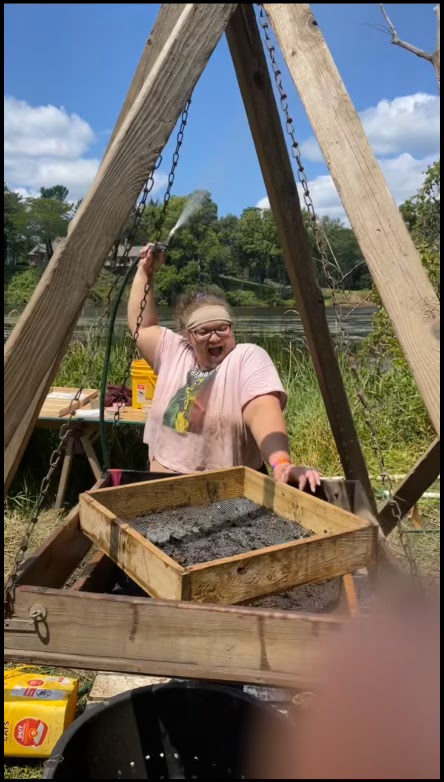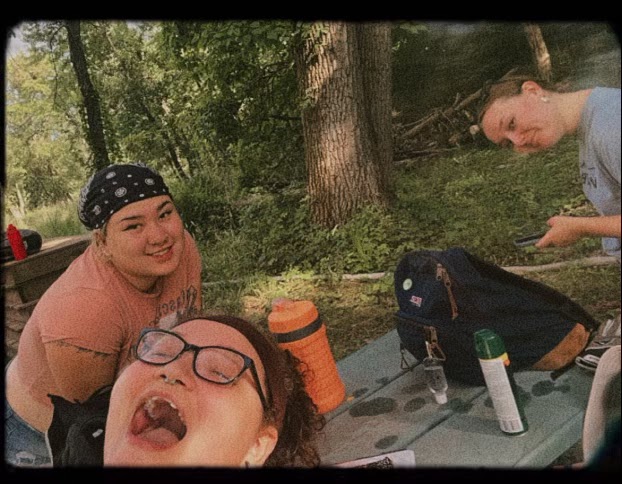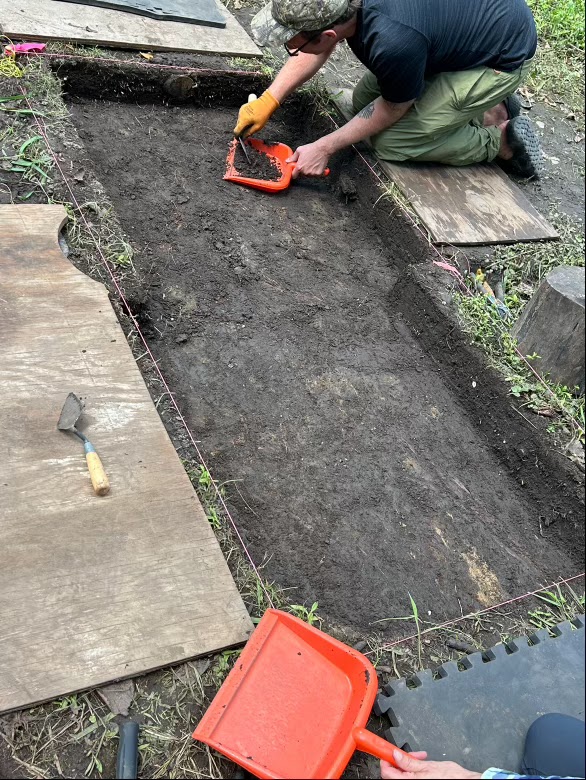 |
First day going to see
the site after flooding |
Being able to go into the field at Fort St. Joseph and getting to start to do some work on the site was an incredible experience. I think the very first time we were on site is when we were looking at how flooded it was. I really wasn't sure where the site started and the river ended. The second time we went into the field we saw it was less flooded and decided to take the plunge and lay out measurements for the trench we decided to dig. Our goal with this trench is to have a wider space to excavate so we can have side by side units and compare their artifact densities. I had missed the first part of the measuring instructions back at the field house but I quickly gathered that the site is on a grid system and to know where we are on the grid we use the point 0'0, referred to as the datum, to find where on the site we need to be. The datum is like a point A spot that determines the exact location of everything else. It's important to use the datum because it helps us know exactly where we are excavating and lets future archaeologists know the locations to look for more artifacts based on our findings. Making sure there was as little human mathematic and physical error as possible took quite some time. I would not have minded it at all, had I not agreed to go out 9 meters and have to completely submerge my feet, shoes and all, ankle deep into water. I'll be honest though, it was very liberating.
 |
| A butterfly visitor |
The next time we went back to the field, it was to do some coring. The point of this was to see if we were disturbing the artifacts by draining the water to excavate, as well as locating potential new areas to dig based on if we found artifacts in the sample. At first I thought we were going to pull dirt out with our coring tool, which was a pvc pipe with screws attached as handles and a make shift air vacuum seal added, and just look at the cylinder of first that comes out of it. But, instead of this, we put all the removed dirt in buckets and wet screened them to see what artifacts we found.  |
Wet screening the core
samples |
A little side story about coring: being able to find artifacts and wash them off for yourself was an amazing experience. You definitely will get soaked because you are spraying water and dirt through a square strainer screen, which then just drips out to your feet, but finding things like lead shot (which I found two of) and cute little seed beads makes it all worth it. When I first though about how we find artifacts while excavating I thought we would be using the naked eye while digging and if we missed anything in the dirt then we just missed it. Wet screening and dry screening solve this by giving us ways to get rid of dirt and just have the small artifacts left. An important thing to note about coring: when you go to push down on the coring tool to get the dirt out, make sure you OPEN the valve to let air out, otherwise it WILL build up with air pressure and shoot you in the neck.
 |
| Me, Vic and Brandy being goofs on site |
The last time we went to the field during the first week, the group that was measuring at the Fort St. Joseph site switched with the second group of students so we could shovel skim and trowel up by the Fort St. Joseph Boulder. We were excavating by the boulder so we could get some practice before digging in the actual units. We are also there because we wanted to make sure the area was clear of artifacts so that one of the returning summer campers could build a trail there. He is hoping to make an accessible ramp up to the boulder so that he can work towards his Eagle Scout badge. While digging in these pits we learned how to trowel, which is using the cute little cake slicer shaped tools to skim the dirt. We also learned how to shovel skim, which is the same as troweling, but with a shovel in order to move more dirt. Another important thing we learned was how to dry screen. The goal of this is the same as wet screening, except instead of using a hose to spray dirt through the screens, we just use our hands to push the dirt. Maybe at the open house you'll be able to see one of us do a very cool trick we developed with the dry screens. Overall, I would say getting to be in the field was amazing. Having to get soaking wet feet was definitely worth it. I'm excited to see what else the field school and Fort St. Joseph have to offer.
- Lonnie
 |
Mine and Jacob's unit (S8W20)
that we opened once the water
levels receded |







Comments
Post a Comment